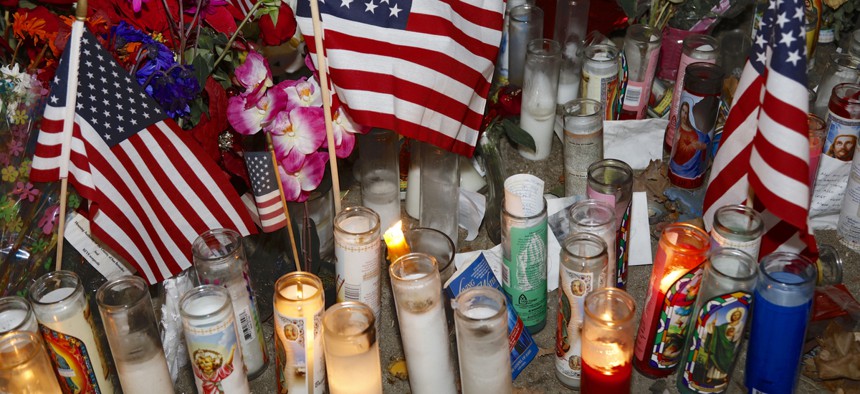'The Mayor Can Set The Tone': How City Leaders Respond to Mass Shootings

Mayors should recognize that they will be the public face of a city's recovery effort, said panelists at the US Conference of Mayors meeting Friday. Shutterstock
Mayors who have seen their cities go through mass shootings discuss how to recover from—and whether it's possible to prepare for—tragedy.
What do you do when you’re the mayor and your community gets rocked by a mass shooting?
Communicate, said Nan Whaley, mayor of Dayton, Ohio, where a gunman killed nine people and shot 17 others in August.
Understand clearly that you’re the one in charge of dealing with it, said Gavin Buckley, mayor of Annapolis, Maryland, where five people were killed in the Capital Gazette newsroom in June 2018.
Create an environment where people can unite and begin to heal, said Buddy Dyer, mayor of Orlando, where 49 people were killed and 53 were wounded in the Pulse nightclub shooting in 2016.
Those mayors, along with seven others whose cities have experienced mass shootings—Lori Lightfoot, Chicago; Andy Berke, Chattanooga, Tennesse; Steven Fulop, Jersey City, New Jersey; Christine Hunschofsky, Parkland, Florida; Sam Liccardo, San Jose, California; Dee Margo, El Paso, Texas and Bill Peduto, Pittsburgh—shared their thoughts on prevention, preparation and recovery in a panel discussion Friday at the U.S. Conference of Mayors winter meeting in Washington, D.C.
Their particular experiences varied, but all agreed that it’s possible to set a positive example for community members in the wake of tragedy.
“The mayor can set the tone,” said Dyer, of Orlando. “That’s what we tried to do from the very first press conference. We came out and said, ‘We’re not going to be defined by this act of hatefulness—we’re going to be defined by our response, which is going to be love, community and compassion.’ ”
The effects of a shooting linger long after it’s over, particularly in cities like Annapolis and Parkland where the suspects are still alive and their cases are going through the court system, Buckley said. But that can serve to unite, rather than divide, residents.
“We have to, as a nation, decide what we’re going to do and who we’re going to be,” he said. “Annapolis didn’t destroy us. I think it brought people together. Out of that sort of darkness, out of that kind of horror, you can come together as a community, and you can show love for one another.”
In smaller towns, where municipal services like police and schools may be run by different entities, mayors can lead a unified response by being vocal and helping residents begin the healing process. In Parkland, the city had no authority over the county schools or the immediate response to the shooting, which was handled by an elected sheriff, Hunschofsky said. So she focused on trying to mitigate the long-term effects of the trauma, speaking publicly about the need for therapy and resources to help residents move past it.
“We focus on our residents, which is important,” she said. “We want to model and let them know that we know it’s going to be ok and we’re going to get through this. And don’t forget about your staff. When there's a traumatic incident in your city, your staff are affected too.”
A quick response and a comprehensive recovery is possible, panelists said. But most agreed that preparation and prevention are mostly impossible tasks. In Annapolis, for example, city staff had undergone active-shooter training a week before the Capital Gazette killings. A journalist from the newspaper was there to cover it, Buckley said. She was one of the five shot to death in her newsroom.
The idea of a mass shooting is unthinkable, the mayors said, but when thought about more comprehensively—not just the incidents that capture national media attention—the shooting deaths of more than one person occur frequently, both across the country and in individual cities.
"We have a mass shooting every week, if that's defined as two or three people getting shot," said Lightfoot, the new Chicago mayor who moderated the discussion. "It's happening every week and in some instances, sadly, multiple times a week in a city like Chicago. We've gotten a lot of really good advice, but I want us to know that in big cities in particular, the level of violence that is happening is something that is vexing all of us."
It can be overwhelming, she said. Victim advocacy and research are important steps that can help communities move forward and heal from tragedy, but at least one root cause has gone largely untreated, she said.
"There are way too many guns out there," she said. "And they're out there in the hands of people who should never have guns."
Kate Elizabeth Queram is a Staff Correspondent for Route Fifty and is based in Washington, D.C.
NEXT STORY: Red States Push for Last-Minute Census Advantage





